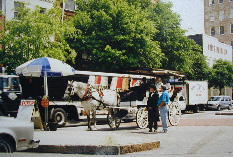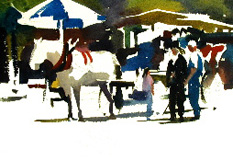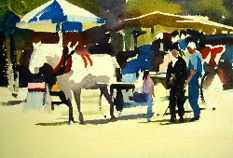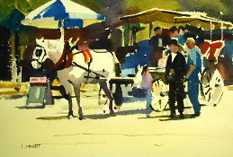Leslie's Technique: Working from Dark to Light
| Inspiration. It
takes more than a charming scene to make a painting. In
this
photo, the sun warmed the surface of the street and
highlighted the horse and figures against the more shadowed
background.
The light unifies the top of the picture into an arresting
pattern of interconnected dark and midtone shapes punctuated
by interesting light shapes. The pattern draws attention
to the horse and carriage and contrasts nicely with the
sunlit street. |
 |
| Step One. Unlike other watercolor artists, I begin with the pattern of darks and midtones. The pattern must carry the painting, so it deserves the concentration and awareness that customarily attends the first brushstrokes. Notice that I paint the pattern, not the objects, allowing the paint to flow from one shape to another--just as I described the scene. I focus primarily on keeping the values pertaining to midtones and darks. |  |
| Step Two. The light wash that describes the sun-washed street is layered over the darker passages. The idea of running a paler wash over darker colors is intimidating to many artists, but it's primarily a matter of developing consummate dexterity with the brush. If you use too heavy a hand or have to repaint the same area repeatedly, you will lift up underlying pigment. It's essential to make every brushstroke count. |  |
Step Three. The painting is now all but done. A few areas are tinted with color to subdue some of the more assertive whites of the untouched paper. Some selected details focus your attention on the horse and carriage as well as describe the time and place. Depending on your point of view, more or less detail could be added to suit your style of painting.
|
"Carriage Ride" by Leslie Frontz |
